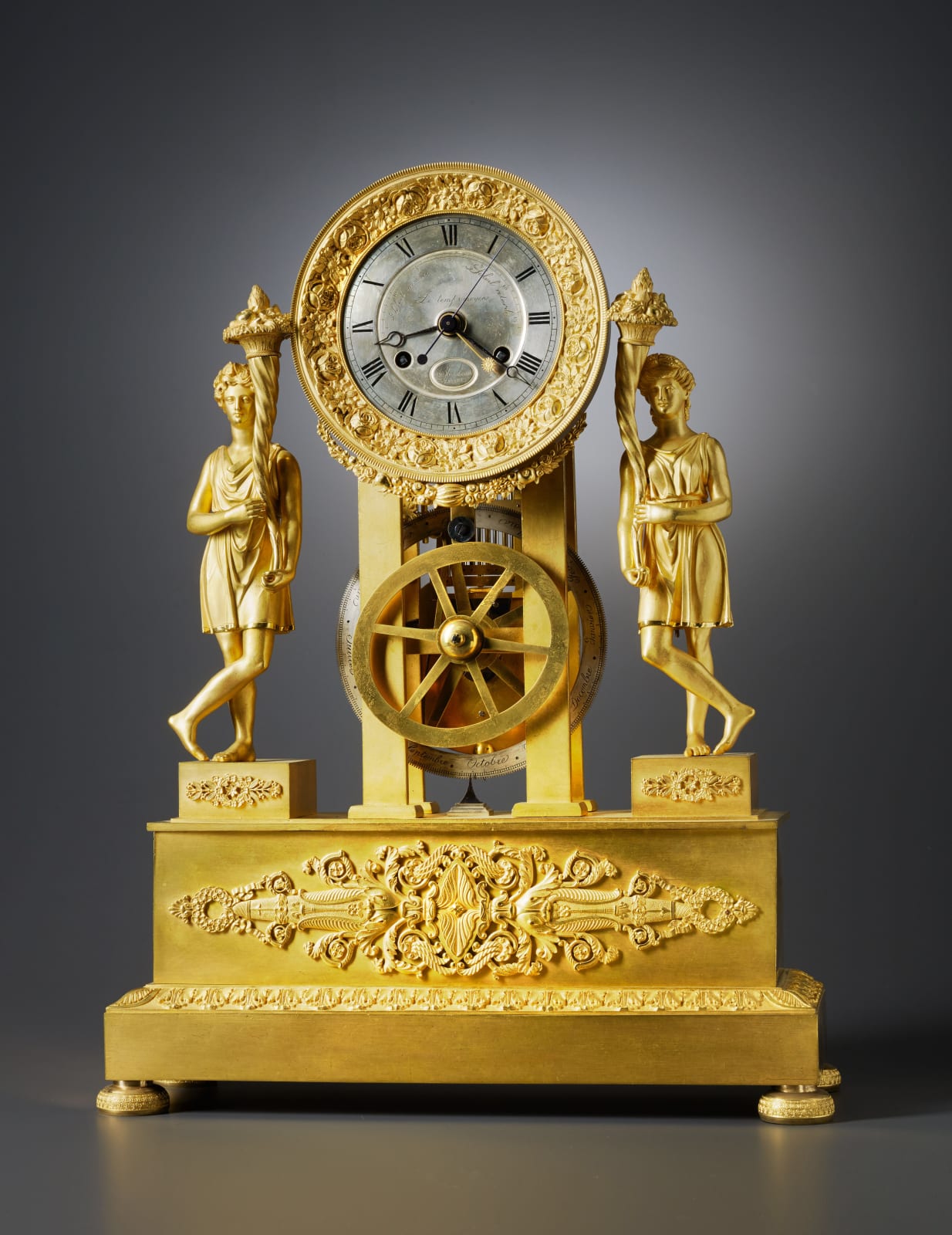Antoine Blondeau
An extremely rare and very beautiful Restauration gilt bronze mantel clock with equation of eight day duration by Blondeau à Paris. The silvered dial, signed within a plaque Blondeau à Paris, with an outer chapter ring marked with indications for the minutes and Roman numerals for the hours with an inner semi-circular ring between 9 and 3 o’clock for the solar minutes inscribed on the left ‘Soleil avance’ and on the right ‘Soleil retarde’ and inscribed below at centre ‘Le temps Moyen’ or mean time, the dial with a pair of blued steel Breguet-style hands for the hours and minutes, a blued steel pointer for the sweep centre seconds and a gilt brass hand with a sunburst pointer to indicate the 16 minute solar minute differentials. The twin barrel spring driven movement, one for the going and one for the striking, with knife edge suspension and pinwheel escapement, striking on the hour and half hours on a single bell, with outside countwheel, mounted on four flat gilded pillars, behind which is a very fine nine rod compensated pendulum with large gilded brass bob with fine adjustment, between the pillars a large five-spoked silvered calendar wheel engraved with the names of the months of the year and having an outer ring for the 365 days of the year, with the date and month being indicated to by a fixed steel pointer below, in front of the pillars an elliptical-shaped six-spoke equation wheel which, connected via the steel rod behind and in turn a series of wheels, then powers the solar minute hand. The beautiful case with dial surmounting the four pillars and set within an ornate gadroon edged bezel cast with alternate sunflowers and roses, with a floral, foliate and fruiting swag below, flanked either side by two elegant female attendants in contrapposto pose, each wearing a foliate headband and short classical tunic and holding aloft a turned cornucopia filled with flowers and fruits while standing cross legged upon a rectangular dais, set upon a rectangular plinth cast with an elaborate foliate and scrolled mount to include wreaths, torches and arrow heads, upon a conformingly shaped stepped base with an acanthus leaf border, supported on four rosette cast bun feet
Paris, date circa 1820-30
Height 57 cm, width 43 cm, depth 15 cm.
The firm of Blondeau à Paris, who made this fine precision clock complete with equation, was run by Antoine Blondeau of 19 rue de la Paix in Paris. One of the most interesting aspects of this clock is the elliptical-shaped equation wheel mounted on the front of the pillars. The wheel rotates once a year and with every slow movement forward it pushes the vertical connecting steel rod behind it slowly up and down during the course of each day. In turn this rod is connected to a series of wheels that power the solar minute hand so that the viewer can read the differential between solar and mean or earth time at any given date in the year. The variation between solar and mean time varies as much as sixteen minutes so that four times a year solar time is in advance of mean time; four times per annum it is behind and four times a year the two coincide. What is truly remarkable is that the equation wheel, with its off-centred elliptical shape, like all the connecting wheel work, was made by hand. This is indeed a great feat of horological engineering in which the mechanism maintained its accuracy to the very second over the course of a year and even more remarkable that it continues to maintain the same degree of accuracy nearly two centuries after its initial creation.
A much admired horloger-mécanicien, Blondeau was appointed Horloger du Roi whose firm was, according to Charles Allix, later succeeded by Lézé à Paris. Blondeau specialised in complex mechanisms, ranging from mantle clocks and carriage clocks to watches, which as here were often housed in extremely elaborate cases. Among them was a complex carriage clock which was bought from Blondeau by the duc de Vallombiosa. As an innovator and inventor, Blondeau often took out patents, counting among them one in 1826 for a movement with ‘perpetual quantième’.
His firm also often exhibited at the more prestigious annual exhibitions including those of 1827, 1834 and 1839. At the 1827 he showed ‘une montre de voyage’ of eight day duration, with calendar and moon phases and grande sonnerie striking. Then at the French Industrial Exhibition, held in Paris 1834, he was awarded a bronze medal and was described in glowing terms by one critic who noted “On lui doit plusieurs perfectionnements aussi utiles qu’ingénieux, apportés dans le fabrication des pendules à grande et petit sonnerie et à réveil. Dans celle des montres il a trouvé une disposition de quantième, au moyen de laquelle il ajoute le vingt-neuvième jour au mois de février, pour les années bissextiles, et cela en n’employant que la roue annuelle ordinaire. Les prix de M Blondeau sont modérés, et il confectionne avec un soin particulier, surtout les montres de voyages. La médaille de bronze lui a été accordée” (“Musée Industriel: Description Complète de l’Exposition des Produits de l’Industrie Française”, 1834, p. 77).
The quality of Blondeau’s mechanisms were matched by his cases, of which the present example is one of the finest and most unusual in having the equation wheel mounted in such a prominent position. Since it is so rare and perhaps unique, it can be assumed that Blondeau’s clock was made an exhibition piece or for an important client.
